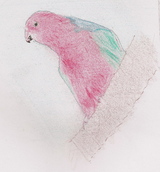As we have seen already, our deeply held feelings of propriety include matters of language and matters of physical contact (for instance, in the form of handshakes, kisses, and hugs in social settings). Today I have one word for you: Food.
Much of what we eat and how we eat is socially determined, from a very early age. If you grow up in a culture where drinking milk is considered healthy, you may find it very hard to actually believe that milk is bad for you—as it is indeed, if not for you personally, then for a great number of adults who can't quite digest milk and yet continue to drink it. If you come from an Asian culture—Japan, for instance—you might find the idea of drinking milk absolutely revolting, and you might find it hard to imagine why on Earth some people would even think of drinking glasses and glasses of the stuff.
You see, the beliefs are so deeply held that we can't quite grasp them; we can't question them; and we can't imagine that other people might see things differently.
Our beliefs about food go well beyond nutritional matters; they include matters of hospitality, of times and spaces shared together. Someone might think like this: Everyone knows meat is an essential part of one's diet. Meat is good for me. I like meat. Meat is good for you. You should like meat. You must like meat. You have no choice but to like meat. I'm going to serve you meat, and if you don't eat it you're not only crazy but rude as well, since you're telling me that I'm wrong to like meat. Mangia, mangia!
In 1988 I went to Berlin for the first time, when the Wall still divided the city. I stayed with a friend of mine for a week, a Brazilian of German descent whom I knew from our shared adolescence in São Paulo. A friend of his—a purely German woman—heard about my presence in the city, and she decided to invite me for dinner. She didn't tell me this, but she wanted to show the distinguished guest something typical of her land. Off I went to her home. Ten or twelve people met: friends of hers, friends of my friends, the sort of incoherent assembly that comes together once and once only. The centerpiece of the meal was a German delicacy, which my hostess had prepared at great cost to her: Eisbein. That's pig's knee. Yes, the knee of a humongous pig, served whole on a plate, with bones, gristle, ligaments, tendons, fat, and a little bit of meat hidden behind the rest of the pig's anatomy.
Each guest was served an entire knee. Plus trimmings, of course—potatoes, cabbage, and whatnot.
I sat looking at it for a long time. It was impossible, this late in the game, for me to pretend I was a vegetarian, or a vegan, or a fish eater, or a monk from a strange sect that only ate pasta and ice cream. No. I had to eat the pig. It had been prepared especially for me, lovingly, by a dedicated German hostess who had gone out of her way to welcome me, a complete stranger, into the bosom of her home.
It wasn't dinner, it was vivisection. The pig looked so pig-like you could hear its squeals. You know what it said? It didn’t say, “Hello, Pedro, I'm delighted to be eaten by you. I'll do my best to go down your throat smoothly. Trust me, we're on the same side here.” No. It said, “I’m a pig, for goodness’ sake. I should be playing in mud right now. If you eat me you’re nothing but a blue-eyed devil.”
After the longest time I took a thin slice of meat from one side of the knee, removed the fat and other anatomic paraphernalia as well as I could, and ate a small forkful of it. One of the guests, a hearty Pole, turned his attention to me. “What's your problem?” he asked. “Are you sick, or something?” He had finished his Eisbein already, and on his plate there remained only the bones. He had consumed, devoured, masticated, and sucked off everything else in his sight.
It has been reported that, in certain Arab communities where hospitality is of the utmost importance, a host might KILL you if you refuse his or her hospitality. It was the awareness of this risk that led me to consume a few more forkfuls of that fateful pig.
Where I come from, the pigs are congressmen and senators. We don't eat them, man!













































